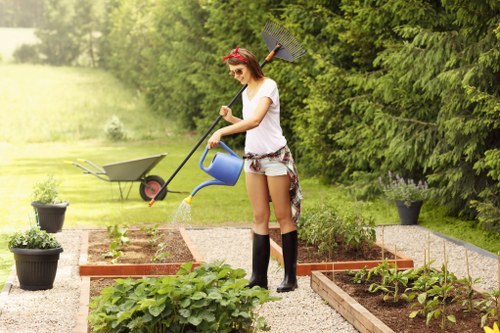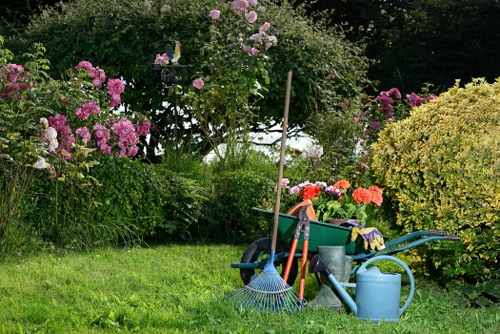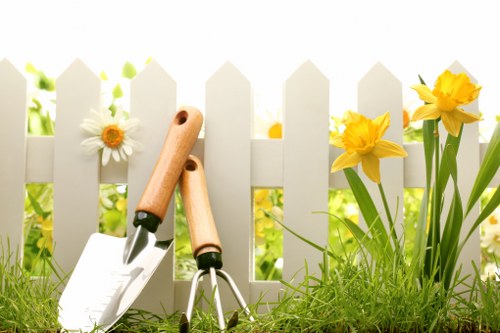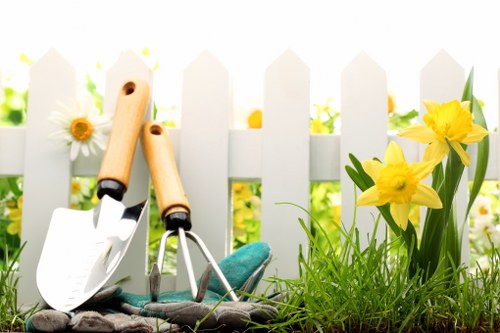Comprehensive Guide to Garden Maintenance in Bills Garden

Introduction to Garden Maintenance
Maintaining a beautiful garden requires dedication, knowledge, and regular care. In Bills Garden, garden maintenance is essential to ensure that the flora thrives and the landscape remains vibrant throughout the year. Whether you're a seasoned gardener or a beginner, understanding the best practices for garden upkeep can transform your outdoor space into a stunning oasis.
Effective garden maintenance involves various tasks, from soil preparation and plant selection to pruning and pest control. By following these guidelines, you can create a healthy, sustainable garden that enhances the beauty of Bills Garden.
In this article, we'll explore the key aspects of garden maintenance, providing you with practical tips and strategies to keep your garden in optimal condition.

Soil Preparation and Fertility
One of the most critical factors in garden maintenance is ensuring the soil is fertile and well-structured. Healthy soil provides the necessary nutrients and support for plant growth, contributing to a lush and vibrant garden.
Soil Testing: Begin by testing your soil to determine its pH level and nutrient content. This information will help you make informed decisions about amendments and fertilizers needed to enhance soil quality.
- pH Levels: Most garden plants thrive in slightly acidic to neutral soil (pH 6.0-7.0).
- Nutrient Content: Assess levels of essential nutrients like nitrogen, phosphorus, and potassium.
Amending the Soil: Based on your soil test results, incorporate organic matter such as compost, manure, or peat moss to improve soil structure and fertility.

Plant Selection and Placement
Choosing the right plants for your garden is crucial for successful maintenance. Select species that are well-suited to the local climate, soil conditions, and the specific microclimate of your garden.
Native Plants: Opt for native or regionally adapted plants as they are more resilient and require less maintenance.
- Advantages: Native plants are adapted to local pests, diseases, and weather conditions.
- Environmental Benefits: They support local wildlife and promote biodiversity.
Plant Placement: Arrange plants according to their sunlight, water, and spacing requirements. Proper placement ensures optimal growth and reduces competition for resources.
Consider grouping plants with similar needs together to streamline your maintenance efforts.

Regular Watering Practices
Consistent and appropriate watering is vital for maintaining plant health. Overwatering or underwatering can lead to a variety of plant issues, including root rot and dehydration.
Watering Schedule: Establish a regular watering schedule based on the specific needs of your plants and the local climate conditions.
- Morning Watering: Watering in the early morning reduces evaporation and allows plants to absorb moisture before the heat of the day.
- Deep Watering: Water deeply to encourage strong root growth, rather than frequent shallow watering.
Efficient Irrigation: Implementing efficient irrigation systems, such as drip irrigation or soaker hoses, can conserve water and ensure plants receive adequate moisture without wastage.
Using mulch around plants can also help retain soil moisture and reduce the frequency of watering.

Pruning and Trimming Techniques
Regular pruning and trimming are essential aspects of garden maintenance, promoting healthy growth and enhancing the aesthetic appeal of your garden.
Why Prune?
Pruning helps remove dead or diseased branches, encourages airflow, and directs plant growth. Proper pruning techniques can prevent overcrowding and ensure plants develop a strong structure.
Tools and Safety
Using the right tools, such as sharp pruning shears and clean loppers, is crucial for effective and safe pruning. Always sanitize your tools before use to prevent the spread of diseases.
Pruning Steps:
- Identify and remove dead or damaged branches.
- Trim back excessively long shoots to encourage branching.
- Shape the plant to maintain its desired form.
Pest and Disease Management
Protecting your garden from pests and diseases is a significant aspect of maintenance. Early detection and integrated pest management strategies can help keep your garden healthy.
Identification: Regularly inspect your plants for signs of pests or diseases, such as discolored leaves, spots, or visible insects.
- Common Pests: Aphids, caterpillars, and slugs are frequent garden invaders.
- Diseases: Fungal infections like powdery mildew or rust can affect plant health.
Control Measures: Use environmentally friendly pest control methods, such as introducing beneficial insects, applying neem oil, or using organic pesticides as needed.
Maintaining plant health through proper watering and fertilization can also reduce susceptibility to pests and diseases.
Mulching and Weed Control
Mulching is a valuable practice in garden maintenance that offers multiple benefits, including moisture retention, temperature regulation, and weed suppression.
Types of Mulch: Organic mulches like bark, straw, and wood chips enrich the soil as they decompose, while inorganic mulches such as gravel or plastic sheeting provide long-term weed control.
- Application: Spread mulch in a layer 2-3 inches thick around plants, avoiding direct contact with stems to prevent rot.
- Weed Control: Mulch acts as a barrier, preventing weed seeds from germinating and reducing the need for manual weeding.
Maintenance: Regularly replenish mulch to maintain its effectiveness and address any compaction or decomposition.
Lawn Care and Maintenance
A well-maintained lawn is a cornerstone of any beautiful garden. Proper lawn care enhances the overall appearance and provides a lush, green backdrop for other garden elements.
Grass Selection: Choose grass varieties suited to your local climate and soil conditions. Common options include fescue, Bermuda, and Kentucky bluegrass.
- Seed or Sod: Decide between seeding for a cost-effective approach or laying sod for immediate results.
- Mowing: Maintain an appropriate mowing height to encourage healthy growth and prevent weed establishment.
Fertilization: Apply lawn fertilizers based on seasonal needs to ensure optimal growth and color.
Weed and Pest Management: Implement strategies to manage common lawn weeds and pests, such as grubs or brown patch disease.
Seasonal Maintenance Tasks
Gardens undergo different challenges throughout the year, making seasonal maintenance crucial for year-round beauty and health.
Spring:
Prepare your garden for the growing season by pruning, fertilizing, and planting new flowers or vegetables.
Summer:
Focus on regular watering, pest control, and maintaining plant health during the peak growing months.
Autumn:
Clean up fallen leaves, plant bulbs for spring blooms, and protect perennials from frost.
Winter:
Perform tasks such as pruning dormant plants, planning for the next season, and protecting sensitive species from extreme cold.
Tools and Equipment for Garden Maintenance
Having the right tools can significantly ease the process of garden maintenance. Invest in quality equipment to ensure efficiency and effectiveness in your gardening tasks.
- Essential Tools: Pruning shears, spades, rakes, and a reliable watering system.
- Advanced Equipment: Lawn mowers, tillers, and composters for larger gardens.
- Safety Gear: Gloves, protective eyewear, and knee pads to ensure safe gardening practices.
Regularly maintain your tools by cleaning and sharpening to extend their lifespan and performance.
Sustainable Gardening Practices
Embracing sustainable practices in garden maintenance not only benefits your garden but also contributes to environmental preservation.
Composting: Recycle organic waste into nutrient-rich compost to improve soil health and reduce landfill contributions.
- Benefits: Enhances soil structure, provides essential nutrients, and promotes beneficial microbial activity.
- How to Compost: Combine green materials (e.g., kitchen scraps) with brown materials (e.g., leaves) and maintain proper moisture and aeration.
Water Conservation: Implement water-saving techniques like rainwater harvesting and using drought-resistant plants to minimize water usage.
Organic Practices: Limit the use of chemical fertilizers and pesticides, opting for natural alternatives to maintain a healthy garden ecosystem.
Creating a Garden Maintenance Schedule
Organizing your garden maintenance tasks into a schedule ensures that no essential activity is overlooked and helps maintain a consistent care routine.
- Weekly Tasks:
- Weeding
- Mowing the lawn
- Checking for pests
- Monthly Tasks:
- Pruning
- Fertilizing
- Inspecting irrigation systems
- Seasonal Tasks:
- Planting and harvesting
- Preparing soil
- Mulching
Utilize a gardening planner or digital calendar to track and schedule these tasks effectively.
Hiring Professional Garden Maintenance Services
For those seeking expert assistance, professional garden maintenance services in Bills Garden offer comprehensive solutions tailored to your garden's specific needs.
Benefits of Hiring Professionals:
- Expertise: Knowledgeable in various aspects of gardening, from plant care to landscape design.
- Time-Saving: Professionals handle time-consuming tasks, allowing you to enjoy your garden without the hassle.
- Customized Care: Services are tailored to address the unique requirements of your garden.
Services Offered: Regular mowing, pruning, fertilization, pest control, irrigation management, and seasonal cleanups.
If you're overwhelmed by garden maintenance tasks, consider consulting with a local expert to maintain the beauty and health of your Bills Garden.
Conclusion
Effective garden maintenance in Bills Garden encompasses a range of activities aimed at promoting plant health, enhancing aesthetic appeal, and ensuring sustainability. By following the guidelines outlined in this article, you can achieve a thriving garden that serves as a beautiful and relaxing outdoor space.
Remember, consistent care and attention are key to a successful garden. Whether you choose to maintain it yourself or hire professional services, investing time and effort into garden maintenance will yield rewarding and long-lasting results.
Contact us today to learn more about our garden maintenance services and how we can help you create the garden of your dreams.